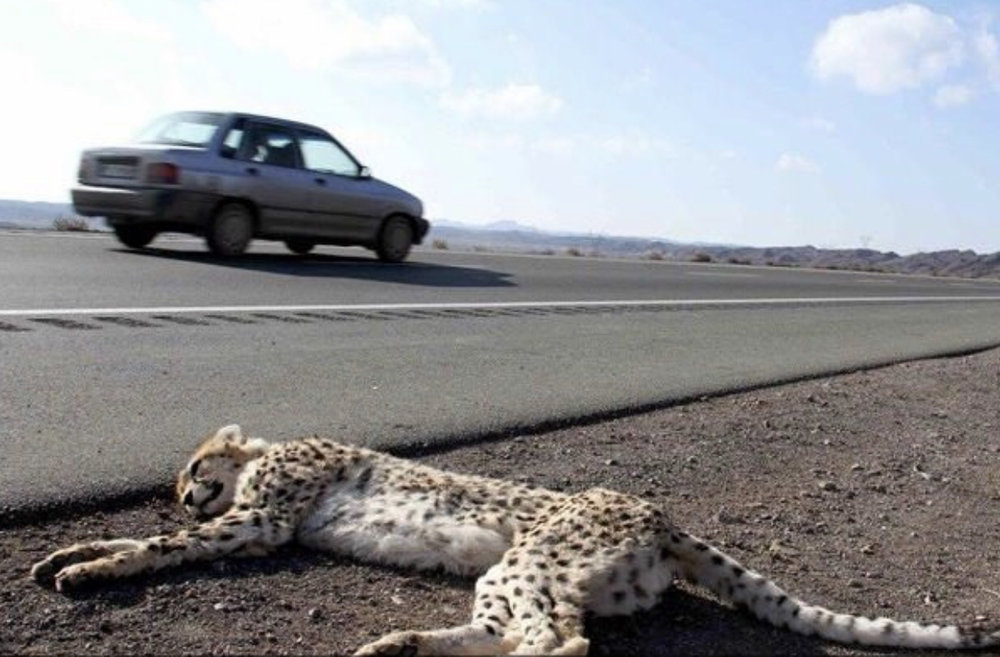What are the potential strategies to mitigate cheetah mortalities on Iran’s roads?

Collisions with vehicles are known to be a source of cheetah mortality in countries such as Iran. In Iran, the critically endangered Asiatic cheetah, with fewer than 50 individuals left in the wild, is particularly susceptible to this threat.
Asiatic cheetahs only occur in central Iran in the provinces of Isfahan, Kerman, North Khorasan, Razavi Khorasan, Semnan, South Khorasan, and Yazd. According to the relevant authorities in Iran’s Department of Environment, collisions with vehicles pose the most serious threat to Asiatic cheetahs.
A total of 17 Asiatic cheetah road-kills were recorded between 2004 and 2018 in Iran. Most cheetah road-kill events occurred on two major highways that run through or between protected areas: the Shahroud-Sabzevar Highway in Semnan Province, which passes between the Touran Biosphere Reserve and the Khosh Yeilagh and Miandasht Wildlife Refuges, and the Mehriz-Anar Expressway, which passes through the Kalmand Protected Area in Yazd Province.
Therefore, reviewing potential strategies to mitigate cheetah fatalities on Iran’s roads is a necessity:
1. Wildlife crossing structures
Wildlife crossing structures can be very effective at reducing road mortality, especially when used in conjunction with fencing. At present there are no wildlife crossing structures in Iran. Larger structures tend to have higher rates of use by carnivores than smaller ones. The location of wildlife crossing structures may be more important than their design. Crossing structures should be constructed where they would have maximum impact. While wildlife crossing structures are successful at reducing road mortality, they do not keep animals off the road: to achieve this fencing is also required.
2. Fencing
Fencing can be very effective at keeping animals away from roads and funneling them towards safe areas to cross such as wildlife crossing structures, thus reducing the rate of road-kill. Fencing alone can, however, fragment habitats and reduce gene flow. This is particularly problematic for small populations of rare species, and could result in reduced genetic diversity due to inbreeding depression. This has the potential to increase vulnerability to disease, for example, which could contribute to population declines and further increase extinction risk. As a result, it is imperative that fencing is used in conjunction with wildlife crossing structures in order to maintain connectivity.
3. Improving lighting
Enhancing road lighting has sometimes been employed to reduce wildlife road fatalities, as better visibility could enhance the ability of drivers to avoid collisions with wildlife. The effectiveness of this, however, has not yet been clearly proven. Furthermore, road lights have significant negative effects on the environment and do not keep animals off roads.
4. Enhance warning signage
To date, the main approach taken to reduce road mortality for the Asiatic cheetah has been centered on the use of wildlife warning signs. The authorities installed 16 warning signs on the Shahroud-Sabzevar Highway in Iran in 2013. Such signs are one of the most frequently used measures to mitigate wildlife road fatalities due to their low cost. There is little evidence, however, that they are effective at reducing road-kill, and it appears that the cheetah warning signs installed in Iran did little to reduce the rate at which cheetahs are killed on the roads. Wildlife warning signs that are spatially- and temporally-specific are more likely to be effective at reducing road-kills.
5. Reducing driver speed
High vehicle speed is an important factor contributing to road mortality. The average speed of vehicles passing through Shahroud-Sabzevar Highway and Mehriz-Anar Expressway exceeds 120 km/h at night and is 90 km/h during the day. Reducing vehicle speed, however, is impractical on large, high-speed roads. Although reducing driver speed at hotspots could help to reduce cheetah mortality rates, introducing lower speed limits and implementing traffic calming measures such as speed bumps are unlikely to be acceptable solutions.
I hope that adopting these measures will go a long way towards reducing the threats posed by roads to the Asiatic cheetah in Iran.
